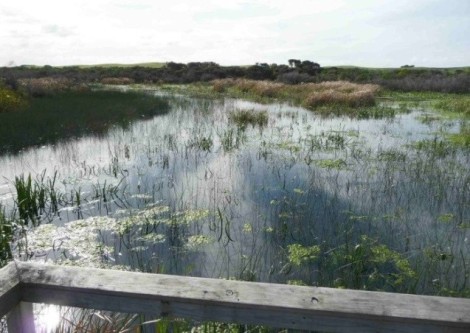Mark Bachmann
Key words: wetland restoration, Ramsar, rising springs, drainage, hydrology
Piccaninnie Ponds Conservation Park is situated 30 km south east of Mt Gambier in South Australia. For 15-20 years after the park was proclaimed in 1969, there was considerable local interest in trying to address previous changes that had been made to the hydrology of the wetland system.
Although it was protected, reserved and supporting a diverse suite of habitats and range of resident threatened species, Piccaninnnie Ponds was far from intact from a hydrological perspective. Prior to European settlement, water that discharged from the karst, rising-spring wetlands in the system flowed eastward across the State border into the Glenelg River Estuary, in far South West Victoria.
This is how the system remained until 1906, when the first of several attempts to drain the wetlands of Piccaninnie Ponds directly to the sea occurred. What ensued was a turbulent 9 year period during which the fishermen successfully lobbied to have the creek re-directed to the Glenelg River in 1915; a step which was ultimately unpopular with affected landholders and resulted in an alternative flow path again being cut to the sea two years later in 1917. Subsequent ad hoc drainage and development of portions of the wetland system continued and by the time the Piccaninnie Ponds Conservatioon Park was proclaimed in 1969, a new main artificial outlet drained the ponds directly to the sea.
The first attempts at advocacy to restore environmental flows to the Glenelg River in the 1970s and 80s to counter this long-term drying trend in the Park were unsuccessful, until the concept was revisited and a series of steps undertaken, starting in 2001, to achieve hydrological restoration. These steps culminated in the following actions.
Actions taken to correct hydrology
- 2006 – Stage 1 weir and fishway constructed at Piccaninnie Ponds (Figure 1) regulated outflows on the artificial outlet. This had the effect of increasing inundation in a small area immediately upstream of the structure, under the direct influence of the weir pool created by the new structure, as shown in Fig 2.
- 2013 – The stage 2 weir and fishway upgrade (Fig 3) resulted in the structure height being lifted to increase future management flexibility, including providing the future ability to completely block outflows, should the option of re-instating the original flow path one day become a reality.
The stage 2 upgrade was completed at the same time as providing a new flow path to physically reconnect the isolated eastern and western basins at Piccaninnie Ponds. These wetlands had been separated for several decades by a combination of lower water levels, sand drift and the impact of the Piccaninnie Ponds Road. An aerial photographic view of the new flow path is shown in Fig 4.
These works within the original Conservation Park, have occurred in in a complementary way with those that have occurred in the neighbouring, newly reserved area at Pick Swamp, each contributing to the wider vision for restoration of this wetland complex.
Results to date.
- Increase in quality and area of available habitat for native freshwater fish, including the nationally threatened Dwarf Galaxias (Galaxiellla pusilla)
- Protection of hydrological processes that support a wide range of other threatened species, from a number of taxonomic groups
- A positive trajectory of change in the distribution of wetland habitats in the vicinity of the works (increased aquatic habitat and reversal of a drying trend that was causing terrestrialisation of vegetation communities)
- Re-establishment of connectivity between the western and eastern wetlands in the Park for the first time in several decades

Fig. 3. The lifted and redesigned stage 2 weir and fishway on the main artificial outlet at Piccaninnie Ponds – upon completion in 2013.
Future directions. The works and outcomes described here were delivered by staff working for the South Australian Department of Environment, Water and Natural Resources (DEWNR)
- Ongoing management of the works and associated ecological monitoring in Piccaninnie Ponds Conservation Park is managed by DEWNR
- Nature Glenelg Trust staff continue to provide specialist ecological advice and monitoring for the site when required by the site manager, DEWNR
Acknowledgements. The outcomes of the restoration project described can be attributed to a wide range of people who, in addition to the author (see current contact details below), worked at the South Australian Department of Environment, Water and Natural Resources during the period described. DEWNR project ecologists overseeing the works described here include Ben Taylor (stage 1 weir) and Steve Clarke (stage 2 weir and associated works).
The project was generously funded and supported by a range of different grants and programs administered by the South Australian Government, Australian Government and the South East Natural Resources Management Board.
Contact. Mark Bachmann. Nature Glenelg Trust, PO Box 2177, Mt Gambier, SA 5290 Australia; Tel +61 (0)8 8797 8181; Mob+61 (0) 421 97 8181; Email: mark.bachmann@natureglenelg.org.au Web| www.natureglenelg.org.au
See also:









